2010 MERCEDES-BENZ SLS COUPE service
[x] Cancel search: servicePage 343 of 361
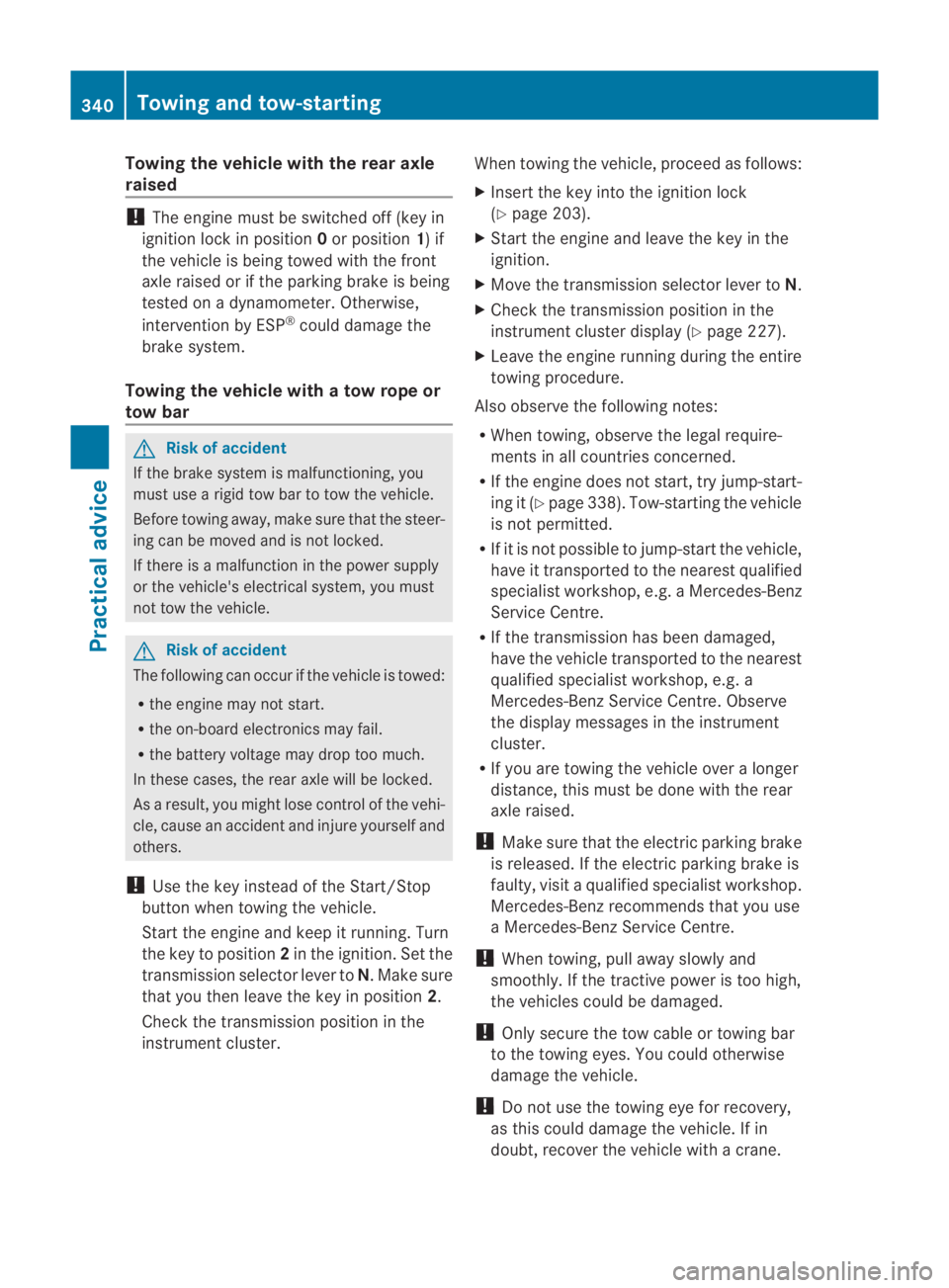
Towing the vehicle with the rear axle
raised !
The engine must be switched off (key in
ignition lock in position 0or position 1) if
the vehicle is being towed with the front
axle raised or if the parking brake is being
tested on a dynamometer. Otherwise,
intervention by ESP ®
could damage the
brake system.
Towing the vehicle with atow rope or
tow bar G
Ris
kofa ccident
If the brake system is malfunctioning, you
must use a rigid tow bar to tow the vehicle.
Before towing away, mak esure that the steer-
ing can be moved and is not locked.
If there is a malfunctio ninthe power supply
or the vehicle's electrical system, you must
not tow the vehicle. G
Risk of accident
The following can occur if the vehicle is towed:
R the engine may not start.
R the on-board electronics may fail.
R the battery voltage may drop too much.
In these cases, the rear axle will be locked.
As a result, you might lose control of the vehi-
cle, cause an accident and injure yourself and
others.
! Use the key instead of the Start/Stop
button when towing the vehicle.
Start the engine and keep it running. Turn
the key to position 2in the ignition. Set the
transmission selector lever to N.Make sure
that you then leave the key in position 2.
Chec kthe transmission position in the
instrument cluster. When towing the vehicle, proceed as follows:
X
Insert the key into the ignition lock
(Y page 203).
X Start the engine and leave the key in the
ignition.
X Move the transmission selector lever to N.
X Check the transmission position in the
instrumentc luster display (Y page 227).
X Leave the engine running during the entire
towing procedure.
Also observe the following notes:
R When towing, observe the legal require-
ments in all countries concerned.
R If the engine does not start, try jump-start-
ing it (Y page 338). Tow-starting the vehicle
is not permitted.
R If it is not possible to jump-star tthe vehicle,
have it transported to the nearest qualified
specialist workshop, e.g. aMercedes-Benz
Service Centre.
R If the transmission has been damaged,
have the vehicle transported to the nearest
qualified specialist workshop, e.g. a
Mercedes-Benz Service Centre. Observe
the display messages in the instrument
cluster.
R If you are towing the vehicle over a longer
distance, this must be done with the rear
axle raised.
! Make sure that the electric parking brake
is released. If the electric parking brake is
faulty, visit a qualified specialist workshop.
Mercedes-Benzr ecommends that you use
a Mercedes-Benz Service Centre.
! When towing, pull away slowly and
smoothly. If the tractive power is too high,
the vehicles could be damaged.
! Only secure the tow cable or towing bar
to the towing eyes. You could otherwise
damage the vehicle.
! Do not use the towing eye for recovery,
as this could damage the vehicle. If in
doubt, recover the vehicle with a crane. 340
Towing and tow-startingPractical advice
BA 197 ECE RE 2010/6a; 1; 2, en-GB
sabbaeu
Version: 3.0.3.6 2010-05-07T14:19:43+02:00 - Seite 340
Page 345 of 361
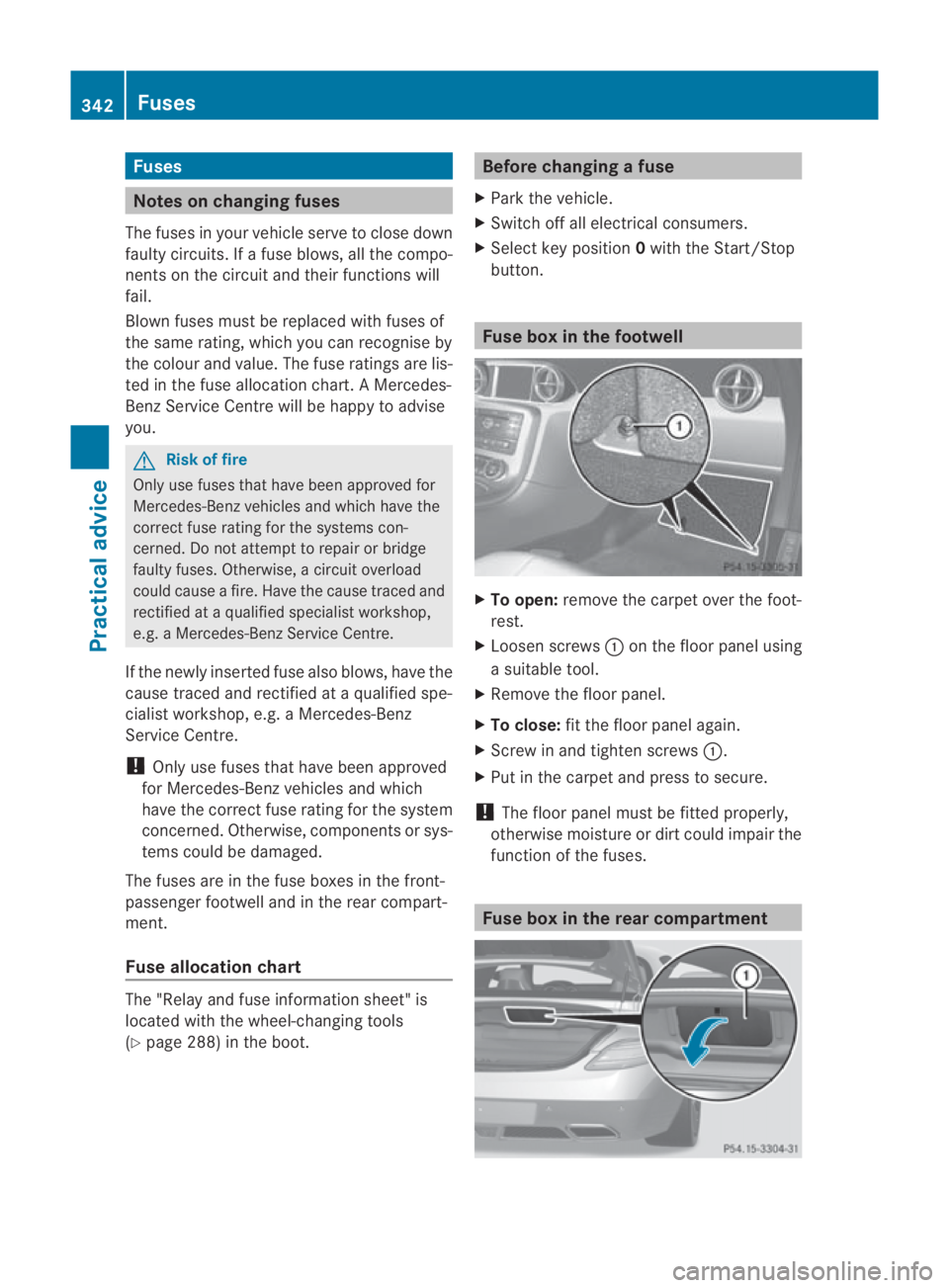
Fuses
Notes on changing fuses
The fuses in your vehicle serve to close down
faulty circuits. If afuse blows, all the compo-
nents on the circuit and their functions will
fail.
Blown fuses must be replace dwith fuses of
the same rating, which you can recognise by
the colour and value. The fuse ratings are lis-
ted in the fuse allocation chart. AMercedes-
BenzS ervice Centre will be happy to advise
you. G
Risk of fire
Only use fuses that have been approved for
Mercedes-Benz vehicles and which have the
correct fuse rating for the systems con-
cerned. Do not attempt to repair or bridge
faulty fuses. Otherwise, a circuit overload
could cause a fire. Have the cause traced and
rectified at a qualified specialist workshop,
e.g. a Mercedes-Benz Service Centre.
If the newly inserted fuse also blows, have the
cause traced and rectified at a qualified spe-
cialist workshop, e.g. a Mercedes-Benz
Service Centre.
! Only use fuses that have been approved
for Mercedes-Benzv ehicles and which
have the correct fuse rating for the system
concerned. Otherwise, components or sys-
tems could be damaged.
The fuses are in the fuse boxes in the front-
passenger footwell and in the rear compart-
ment.
Fuse allocation chart The "Relay and fuse information sheet" is
located with the wheel-changing tools
(Y page 288) in the boot. Before changing a fuse
X Park the vehicle.
X Switch off all electrical consumers.
X Select key position 0with the Start/Stop
button. Fuse box in the footwell
X
To open: remove the carpet over the foot-
rest.
X Loosen screws 0001on the floor panel using
a suitable tool.
X Remove the floor panel.
X To close: fit the floor panel again.
X Screw in and tighten screws 0001.
X Put in the carpet and press to secure.
! The floor panel must be fitted properly,
otherwise moisture or dirt could impair the
function of the fuses. Fuse box in the rear compartment342
FusesPractical advice
BA 197 ECE RE 2010/6a; 1; 2, en-GB
sabbaeu
Version: 3.0.3.6 2010-05-07T14:19:43+02:00 - Seite 342
Page 348 of 361
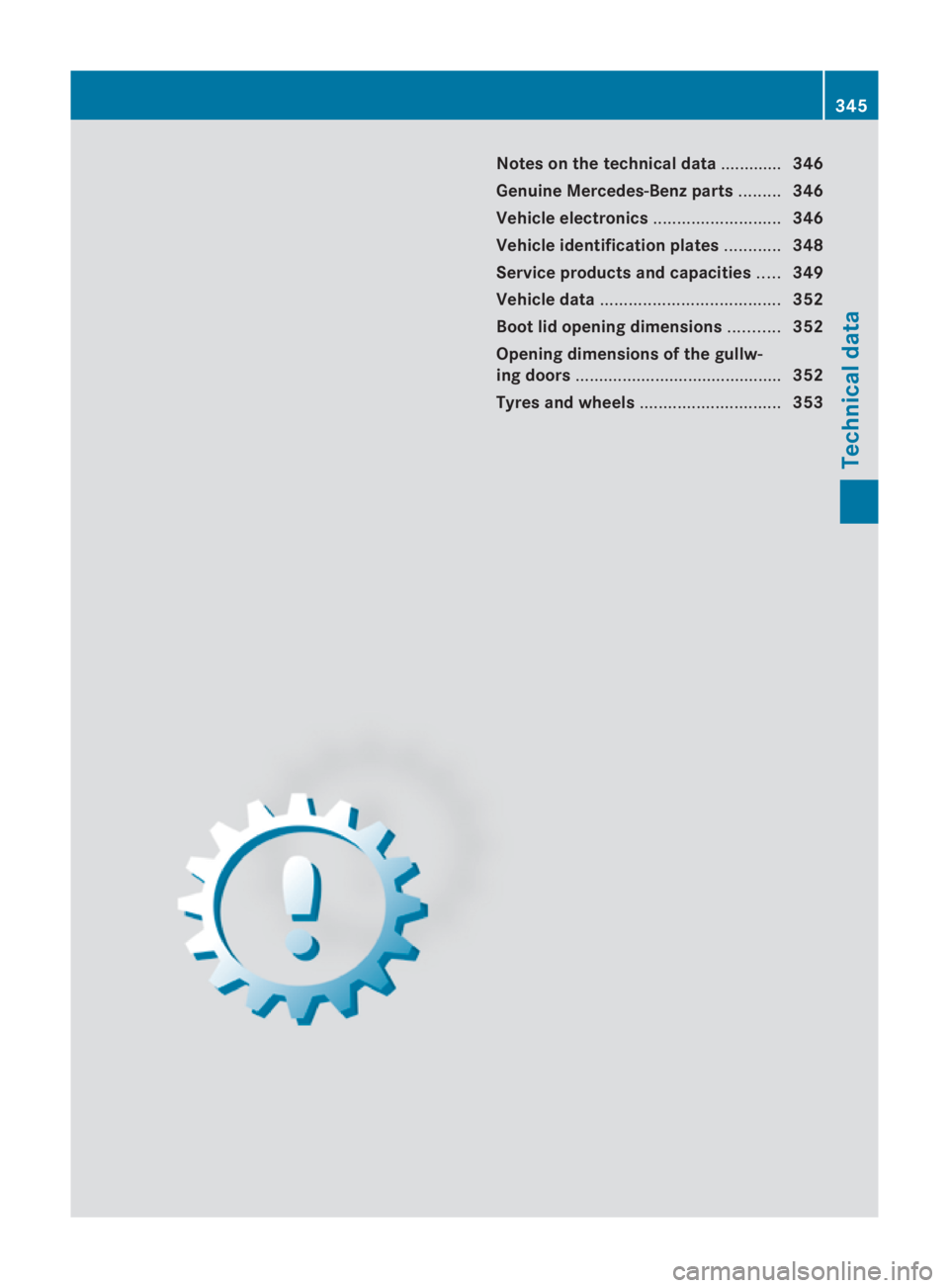
Notes on the technical data
.............346
Genuine Mercedes-Benz parts .........346
Vehicle electronics ...........................346
Vehicle identification plates ............348
Service products and capacities .....349
Vehicle data ...................................... 352
Boot lid opening dimensions ...........352
Opening dimensions of the gullw-
ing doors ............................................ 352
Tyres and wheels .............................. 353 345Technical data
BA 197 ECE RE 2010/6a; 1; 2, en-GB
sabbaeu
Version: 3.0.3.6 2010-05-07T14:19:43+02:00 - Seite 345
Page 349 of 361
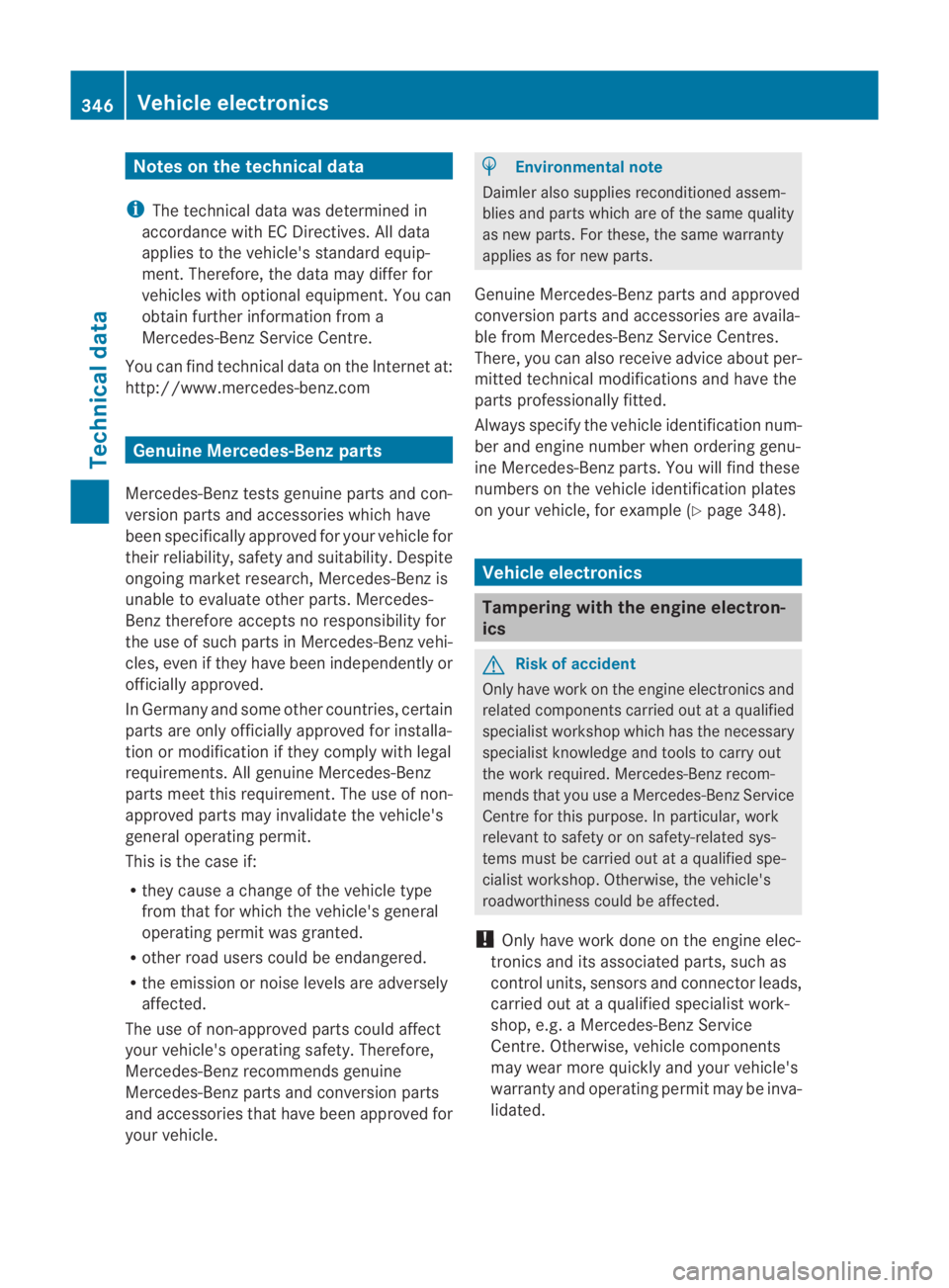
Notes on the technical data
i The technical data was determined in
accordance with EC Directives. All data
applies to the vehicle's standard equip-
ment. Therefore, the data may differ for
vehicles with optional equipment. You can
obtain further information from a
Mercedes-Benz Service Centre.
You can find technical data on the Internet at:
http://www.mercedes-benz.com Genuine Mercedes-Benz parts
Mercedes-Benz tests genuine parts and con-
version parts and accessories which have
been specifically approved for your vehicle for
their reliability, safety and suitability. Despite
ongoing market research, Mercedes-Benz is
unable to evaluate other parts. Mercedes-
Benz therefore accepts no responsibility for
the use of such parts in Mercedes-Benz vehi-
cles, eve nifthey have been independently or
officially approved.
In Germany and some other countries, certain
parts are only officially approved for installa-
tion or modification if they comply with legal
requirements. All genuine Mercedes-Benz
parts meet this requirement. The use of non-
approved parts may invalidate the vehicle's
general operating permit.
This is the case if:
R they cause a change of the vehicle type
from that for which the vehicle's general
operating permit was granted.
R other road users could be endangered.
R the emission or noise levels are adversely
affected.
The use of non-approved parts could affect
your vehicle's operating safety. Therefore,
Mercedes-Ben zrecommends genuine
Mercedes-Benz parts and conversion parts
and accessories that have been approved for
your vehicle. H
Environmental note
Daimler also supplies reconditioned assem-
blies and parts which are of the same quality
as new parts. For these, the same warranty
applies as for new parts.
Genuine Mercedes-Benzp artsa nd approved
conversion parts and accessories are availa-
ble from Mercedes-Benz Service Centres.
There, you can also receive advice abou tper-
mitted technical modifications and have the
parts professionally fitted.
Always specify the vehicle identification num-
ber and engine number when ordering genu-
ine Mercedes-Benzp arts. You will find these
numbers on the vehicle identification plates
on your vehicle, for example ( Ypage 348). Vehicle electronics
Tampering with the engine electron-
ics
G
Ris
kofa ccident
Only have work on the engine electronics and
related components carried out at a qualified
specialist workshop which has the necessary
specialist knowledge and tools to carry out
the work required. Mercedes-Benz recom-
mends that you use a Mercedes-Ben zService
Centre for this purpose. In particular, work
relevant to safety or on safety-related sys-
tems must be carried out at a qualified spe-
cialist workshop. Otherwise, the vehicle's
roadworthiness could be affected.
! Only have work done on the engine elec-
tronics and its associated parts, such as
control units, sensors and connector leads,
carried out at a qualified specialist work-
shop, e.g. a Mercedes-Benz Service
Centre. Otherwise, vehicle components
may wear more quickly and your vehicle's
warranty and operating permit may be inva-
lidated. 346
Vehicle electronicsTechnical data
BA 197 ECE RE 2010/6a; 1; 2, en-GB
sabbaeu
Version: 3.0.3.6 2010-05-07T14:19:43+02:00 - Seite 346
Page 350 of 361
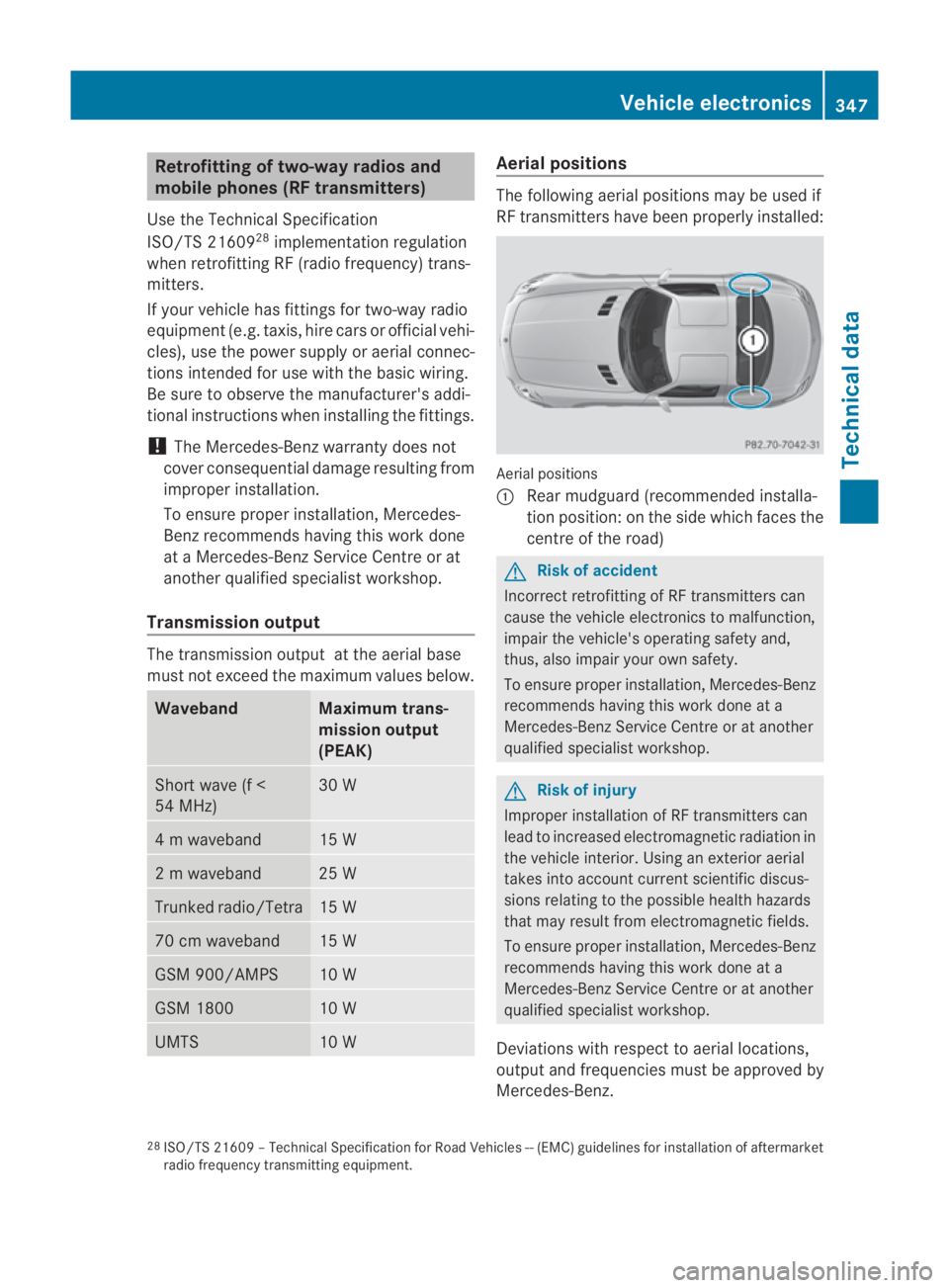
Retrofitting of two-way radios and
mobile phones (RF transmitters)
Use the Technical Specification
ISO/TS 21609 28
implementation regulation
when retrofitting RF (radio frequency) trans-
mitters.
If your vehicle has fittings for two-way radio
equipment (e.g. taxis, hire cars or official vehi-
cles), use the power supply or aerial connec-
tions intended for use with the basic wiring.
Be sure to observe the manufacturer's addi-
tional instructions when installing the fittings.
! The Mercedes-Benz warranty does not
cove rconsequential damage resulting from
improper installation.
To ensure proper installation, Mercedes-
Benz recommends having this work done
at a Mercedes-Benz Service Centre or at
another qualified specialist workshop.
Transmission output The transmission output at the aerial base
must not exceed the maximum values below.
Waveband Maximum trans-
mission output
(PEAK)
Short wave (f <
54 MHz) 30 W
4 m waveband 15 W
2 m waveband 25 W
Trunked radio/Tetra 15 W
70 cm waveband 15 W
GSM 900/AMPS 10 W
GSM 1800 10 W
UMTS 10 W Aerial positions
The following aerial positions may be used if
RF transmitters have been properly installed:
Aerial positions
0001
Rear mudguard (recommended installa-
tion position: on the side which faces the
centre of the road) G
Risk of accident
Incorrect retrofitting of RF transmitters can
cause the vehicle electronics to malfunction,
impair the vehicle's operating safety and,
thus, also impair your own safety.
To ensure proper installation, Mercedes-Benz
recommends having this work done at a
Mercedes-Benz Service Centre or at another
qualified specialist workshop. G
Risk of injury
Improper installation of RF transmitters can
lead to increased electromagnetic radiation in
the vehicle interior .Using an exterior aerial
takes into account current scientific discus-
sions relating to the possible health hazards
that may result from electromagnetic fields.
To ensure proper installation, Mercedes-Benz
recommends having this work done at a
Mercedes-Benz Service Centre or at another
qualified specialist workshop.
Deviations with respect to aerial locations,
output and frequencies must be approved by
Mercedes-Benz.
28 ISO/TS 21609 –Technical Specification for Road Vehicles -- (EMC) guidelines for installation of aftermarket
radio frequency transmitting equipment. Vehicle electronics
347Technical data
BA 197 ECE RE 2010/6a; 1; 2, en-GB
sabbaeu Version: 3.0.3.6 2010-05-07T14:19:43+02:00 - Seite 347 Z
Page 352 of 361
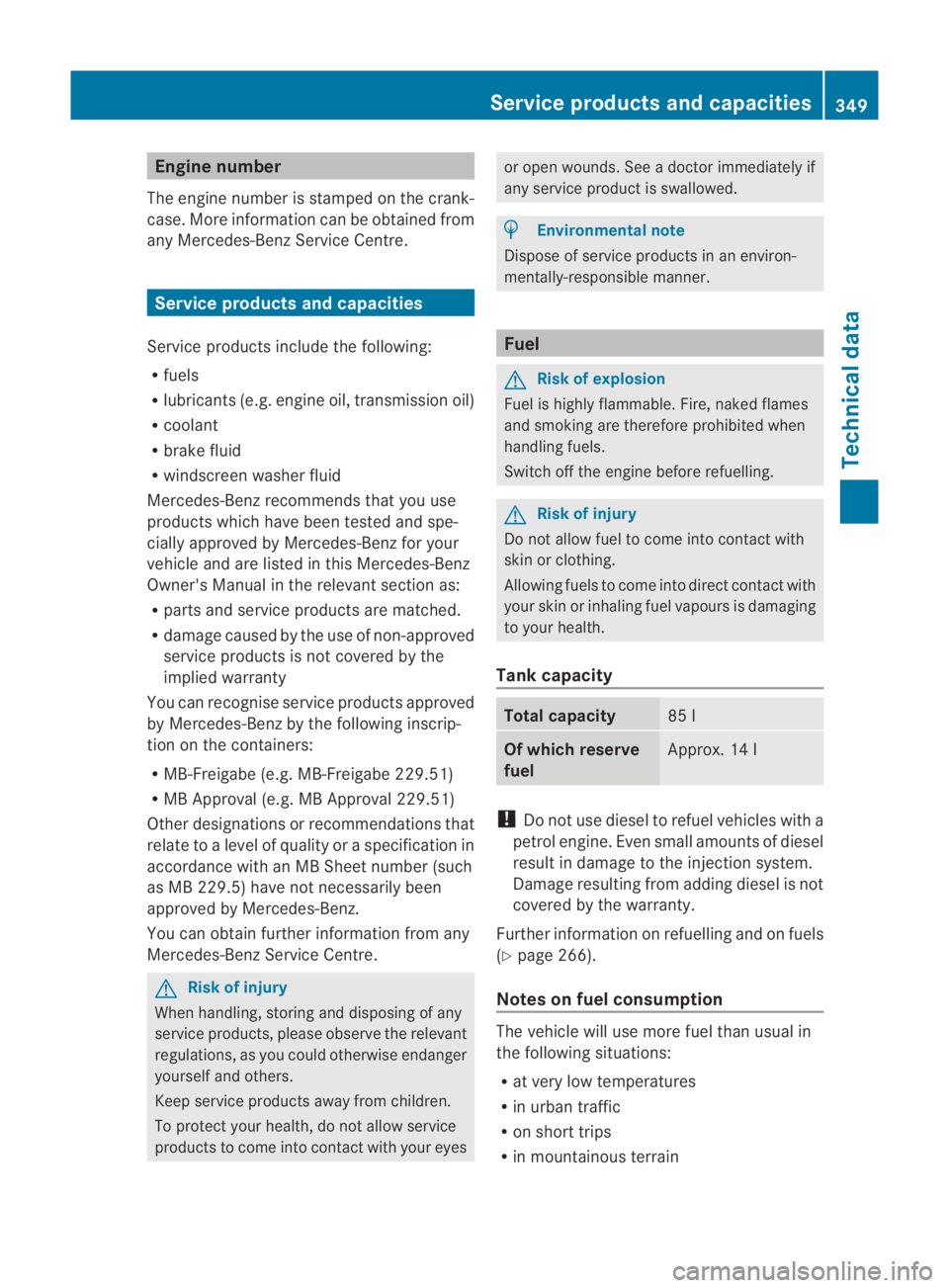
Engine number
The engine number is stamped on the crank-
case. More informatio ncan be obtained from
any Mercedes-Benz Service Centre. Service products and capacities
Service products include the following:
R fuels
R lubricants (e.g. engine oil, transmission oil)
R coolant
R brake fluid
R windscree nwasher fluid
Mercedes-Ben zrecommends that you use
products which have been tested and spe-
cially approved by Mercedes-Benz for your
vehicle and are listed in this Mercedes-Benz
Owner's Manual in the relevant section as:
R parts and service products are matched.
R damage caused by the use of non-approved
service products is not covered by the
implied warranty
You can recognise service products approved
by Mercedes-Benz by the following inscrip-
tion on the containers:
R MB-Freigabe (e.g. MB-Freigabe 229.51)
R MB Approval (e.g. MB Approval 229.51)
Other designations or recommendations that
relate to a level of quality or a specification in
accordance with an MB Sheet number (such
as MB 229.5) have not necessarily been
approved by Mercedes-Benz.
You can obtain further information from any
Mercedes-Benz Service Centre. G
Risk of injury
When handling, storing and disposing of any
service products, please observe the relevant
regulations, as you could otherwise endanger
yourself and others.
Keep service products away from children.
To protec tyour health, do not allow service
products to come into contact with your eyes or open wounds. See a doctor immediately if
any service product is swallowed.
H
Environmental note
Dispose of service products in an environ-
mentally-responsible manner. Fuel
G
Risk of explosion
Fuel is highly flammable. Fire, naked flames
and smoking are therefore prohibited when
handling fuels.
Switch off the engine before refuelling. G
Risk of injury
Do not allow fuel to come into contact with
skin or clothing.
Allowing fuels to come into direct contact with
your skin or inhaling fuel vapours is damaging
to your health.
Tank capacity Total capacity
85 l
Of which reserve
fuel
Approx. 14 l
!
Do not use diesel to refuel vehicles with a
petrol engine. Even small amounts of diesel
result in damage to the injection system.
Damage resulting from adding diesel is not
covered by the warranty.
Further information on refuelling and on fuels
(Y page 266).
Notes on fuel consumption The vehicle will use more fuel than usual in
the following situations:
R
at very low temperatures
R in urban traffic
R on short trips
R in mountainous terrain Service products and capacities
349Technical data
BA 197 ECE RE 2010/6a; 1; 2, en-GB
sabbaeu Version: 3.0.3.6 2010-05-07T14:19:43+02:00 - Seite 349 Z
Page 353 of 361
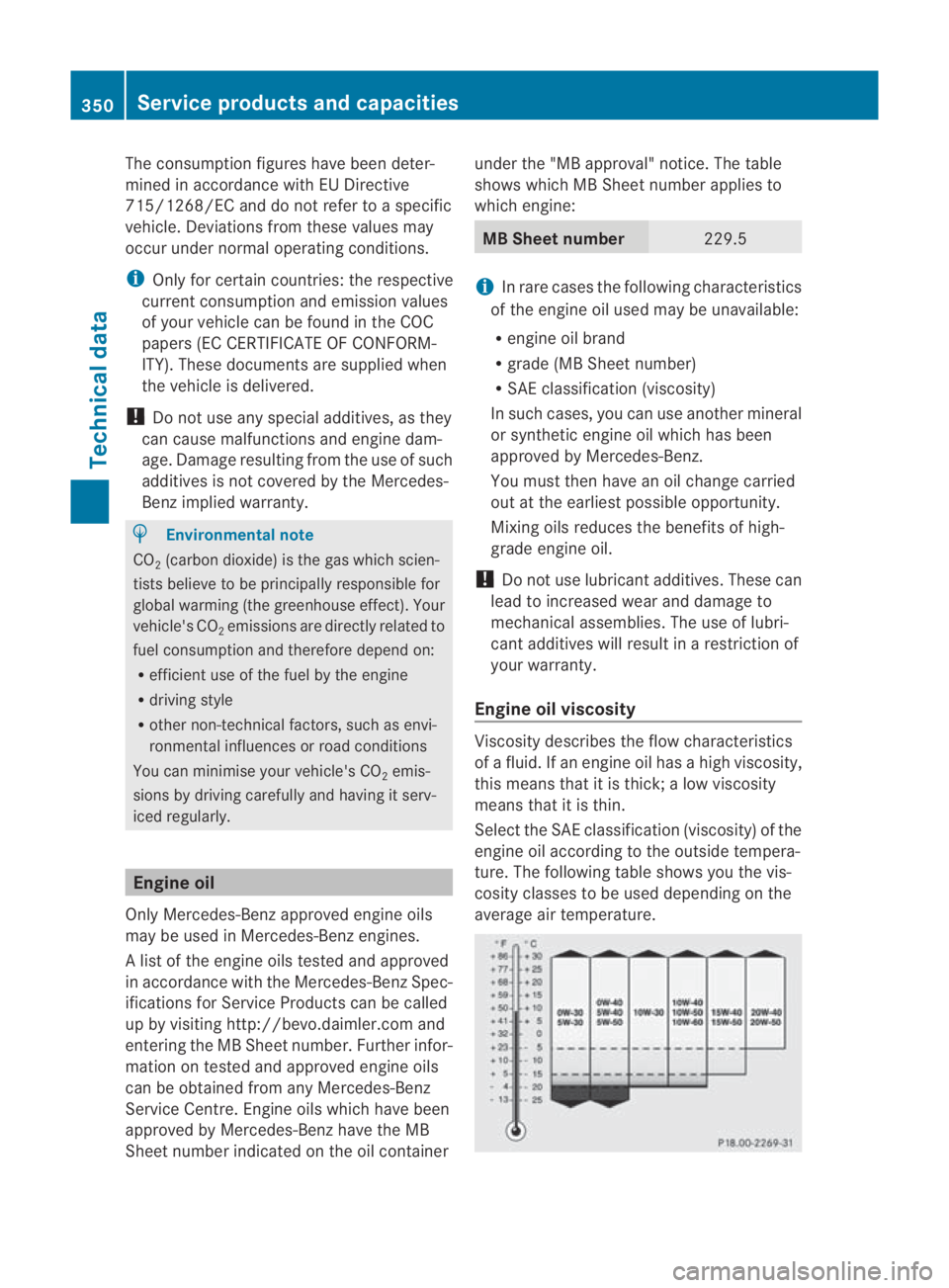
The consumption figures have been deter-
mined in accordance with EU Directive
715/1268/EC and do not refer to a specific
vehicle. Deviations from these values may
occur under normal operating conditions.
i Only for certain countries: the respective
curren tconsumption and emission values
of your vehicle can be found in the COC
papers (EC CERTIFICATE OF CONFORM-
ITY). These documents are supplied when
the vehicle is delivered.
! Do not use any special additives, as they
can cause malfunctions and engine dam-
age. Damage resulting from the use of such
additives is not covered by the Mercedes-
Benz implied warranty. H
Environmental note
CO 2(carbon dioxide) is the gas which scien-
tists believe to be principally responsible for
global warming (the greenhouse effect). Your
vehicle's CO 2emissions are directly related to
fuel consumption and therefore depend on:
R efficient use of the fuel by the engine
R driving style
R other non-technical factors, such as envi-
ronmental influences or road conditions
You can minimise your vehicle's CO 2emis-
sions by driving carefully and having it serv-
iced regularly. Engine oil
Only Mercedes-Benz approved engine oils
may be used in Mercedes-Benz engines.
Al ist of the engine oils tested and approved
in accordance with the Mercedes-Ben zSpec-
ifications for Service Products can be called
up by visiting http://bevo.daimler.com and
entering the MB Sheet number. Further infor-
mation on tested and approved engine oils
can be obtained from any Mercedes-Benz
Service Centre. Engine oils which have been
approved by Mercedes-Benz have the MB
Sheet number indicated on the oil container under the "MB approval" notice. The table
shows which MB Sheet number applies to
which engine: MB Sheet number
229.5
i
In rare cases the following characteristics
of the engine oil used may be unavailable:
R engine oil brand
R grade (MB Sheet number)
R SAEc lassification (viscosity)
In such cases, you can use another mineral
or synthetic engine oil which has been
approved by Mercedes-Benz.
You must the nhave an oil change carried
out at the earliest possible opportunity.
Mixing oils reduces the benefits of high-
grade engine oil.
! Do no tuse lubricant additives. These can
lead to increased wear and damage to
mechanical assemblies. The use of lubri-
cant additives will result in a restriction of
your warranty.
Engine oil viscosity Viscosity describes the flow characteristics
of a fluid. If an engine oil has a high viscosity,
this means that it is thick; a low viscosity
means that it is thin.
Select the SAE classification (viscosity) of the
engine oil according to the outside tempera-
ture. The following table shows you the vis-
cosity classes to be used depending on the
average air temperature. 350
Service products and capacitiesTechnical data
BA 197 ECE RE 2010/6a; 1; 2, en-GB
sabbaeu
Version: 3.0.3.6 2010-05-07T14:19:43+02:00 - Seite 350
Page 354 of 361
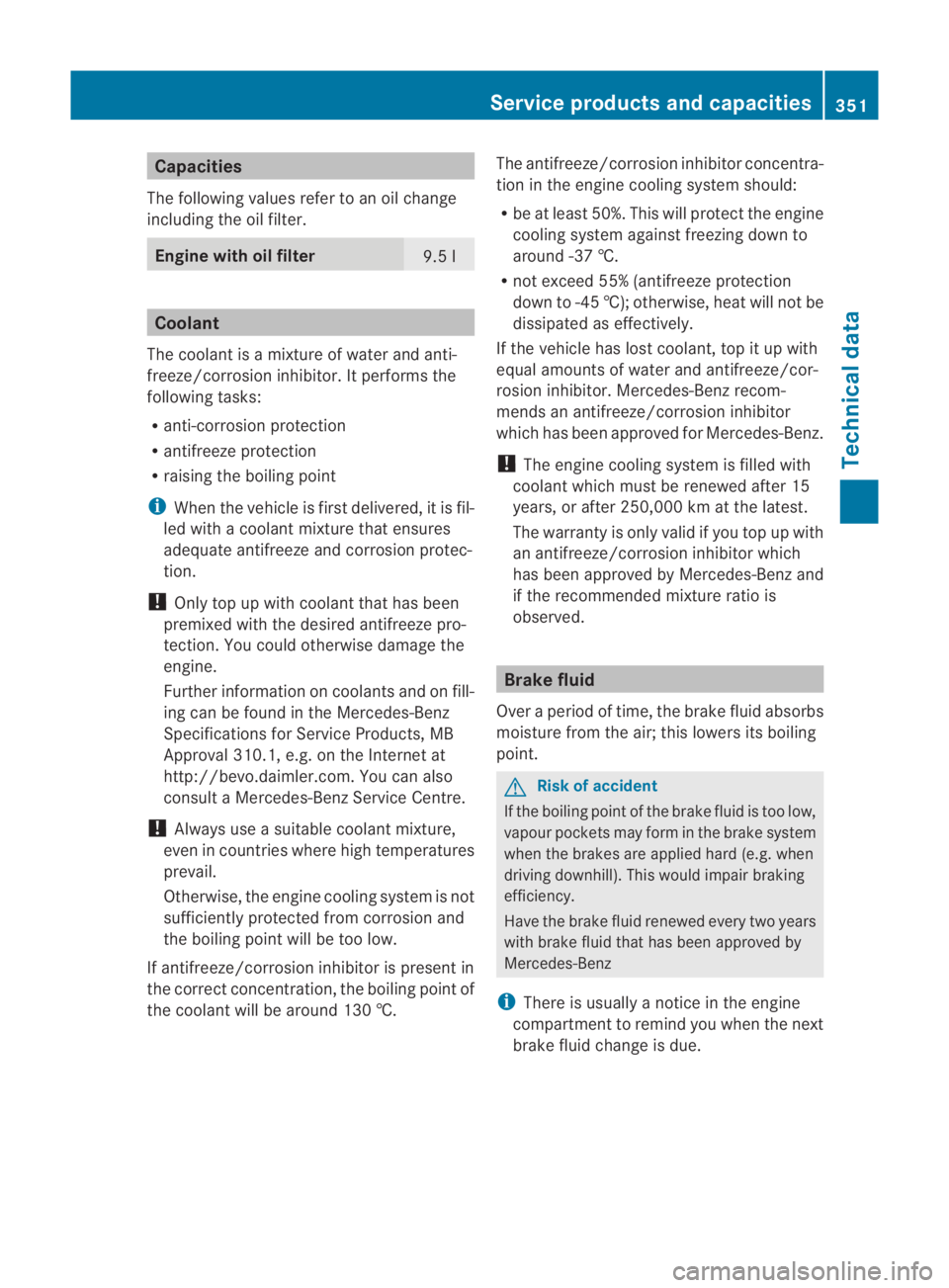
Capacities
The following values refer to an oil change
including the oil filter. Engine with oil filter
9.5 l
Coolant
The coolan tis a mixture of water and anti-
freeze/corrosion inhibitor. It performs the
following tasks:
R anti-corrosion protection
R antifreeze protection
R raising the boiling point
i When the vehicle is first delivered, it is fil-
led with a coolant mixture that ensures
adequate antifreeze and corrosion protec-
tion.
! Only top up with coolant that has been
premixed with the desired antifreeze pro-
tection. You could otherwise damage the
engine.
Further information on coolants and on fill-
ing can be found in the Mercedes-Benz
Specifications for Service Products, MB
Approval 310.1, e.g. on the Internet at
http://bevo.daimler.com. You can also
consult a Mercedes-Benz Service Centre.
! Always use a suitable coolant mixture,
even in countries where high temperatures
prevail.
Otherwise, the engine cooling system is not
sufficiently protected from corrosion and
the boiling point will be too low.
If antifreeze/corrosion inhibitor is present in
the correct concentration, the boiling point of
the coolant will be around 130 †. The antifreeze/corrosion inhibitor concentra-
tion in the engine cooling system should:
R
be at least 50%. This will protect the engine
cooling system against freezing down to
around -37 †.
R not exceed 55% (antifreeze protection
down to -45 †); otherwise, heat will not be
dissipated as effectively.
If the vehicle has lost coolant, top it up with
equal amounts of water and antifreeze/cor-
rosion inhibitor. Mercedes-Benz recom-
mends an antifreeze/corrosion inhibitor
which has been approved for Mercedes-Benz.
! The engine cooling system is filled with
coolant which must be renewed after 15
years, or after 250,000 km at the latest.
The warranty is only valid if you top up with
an antifreeze/corrosion inhibitor which
has been approved by Mercedes-Benz and
if the recommended mixture ratio is
observed. Brake fluid
Over a period of time, the brake fluid absorbs
moisture from the air; this lowers its boiling
point. G
Risk of accident
If the boiling point of the brake fluid is too low,
vapour pockets may form in the brake system
when the brakes are applied hard (e.g. when
driving downhill).T his would impair braking
efficiency.
Have the brake fluid renewed every two years
with brake fluid that has been approved by
Mercedes-Benz
i There is usually a notice in the engine
compartmentt o remind you when the next
brake fluid change is due. Service products and capacities
351Technical data
BA 197 ECE RE 2010/6a; 1; 2, en-GB
sabbaeu Version: 3.0.3.6 2010-05-07T14:19:43+02:00 - Seite 351 Z